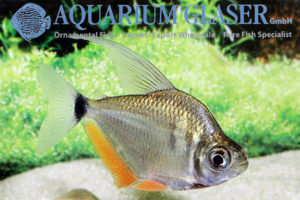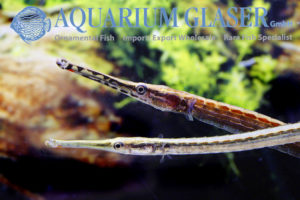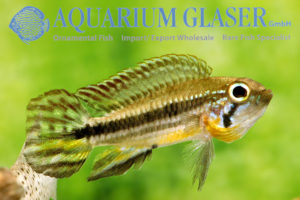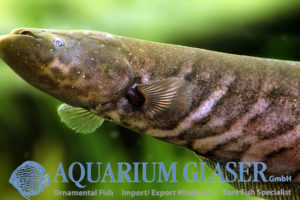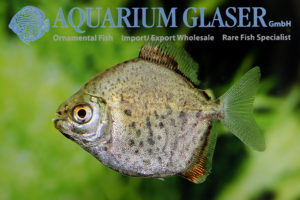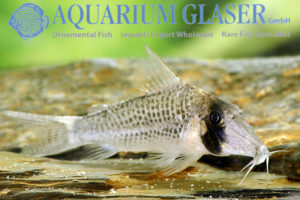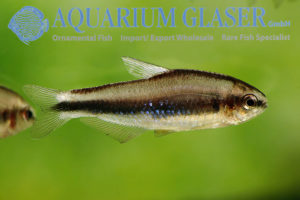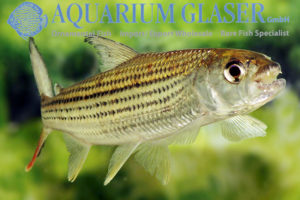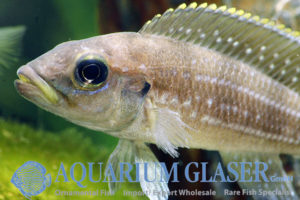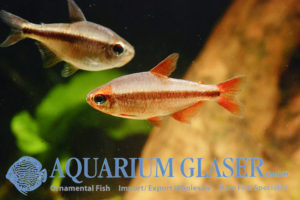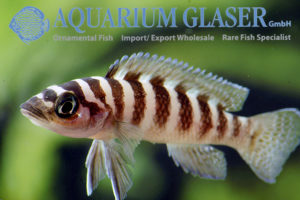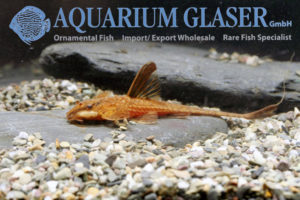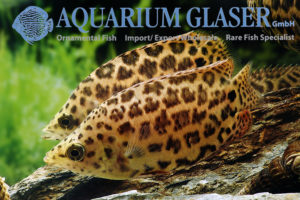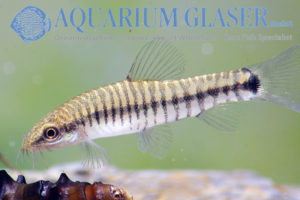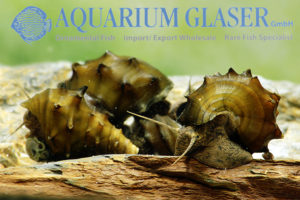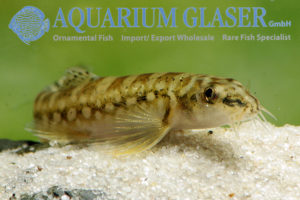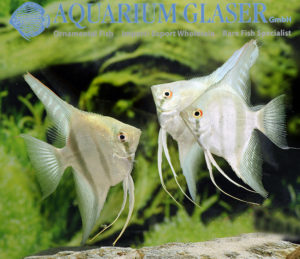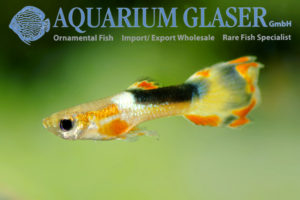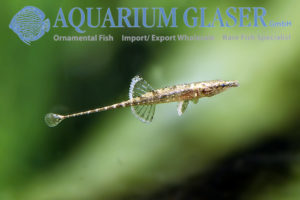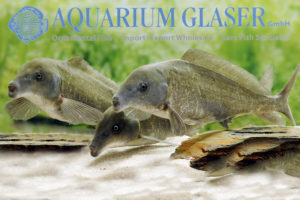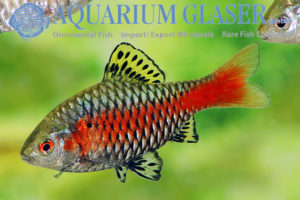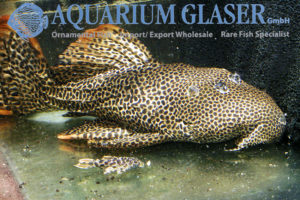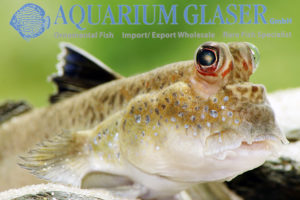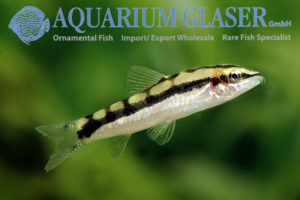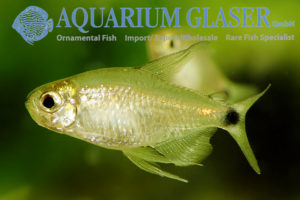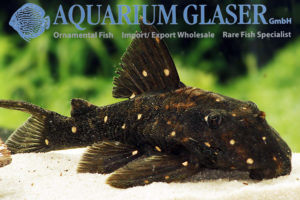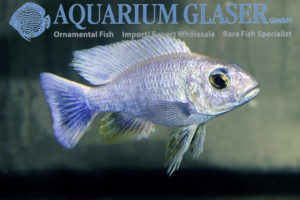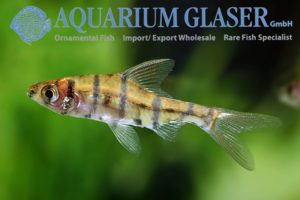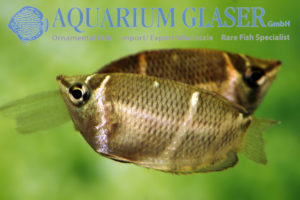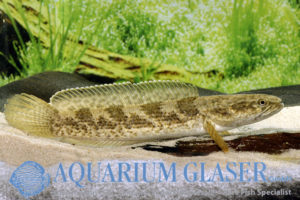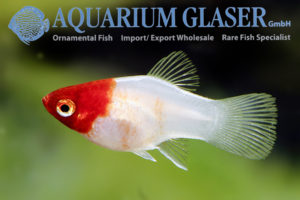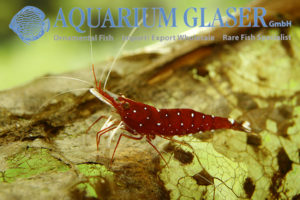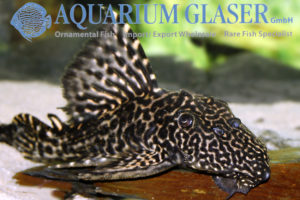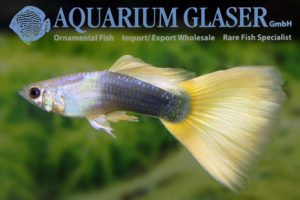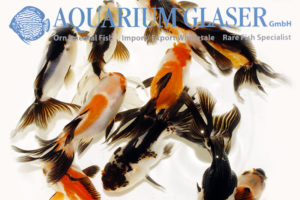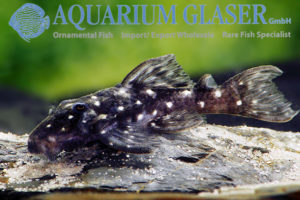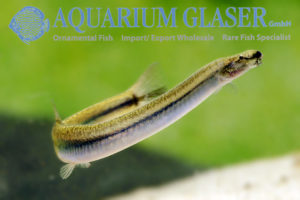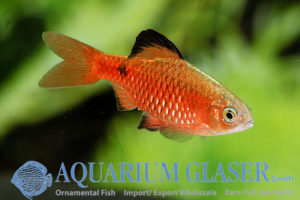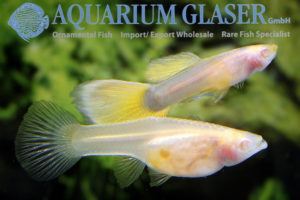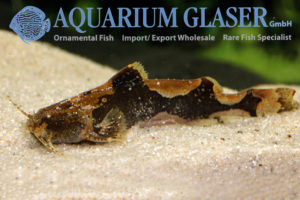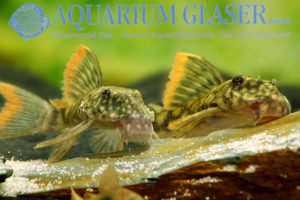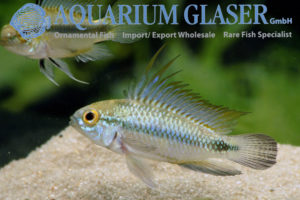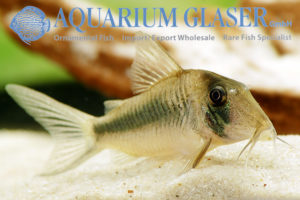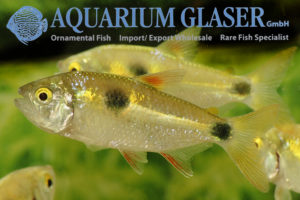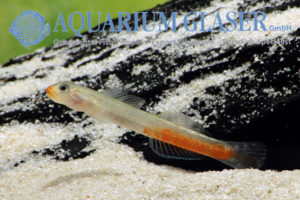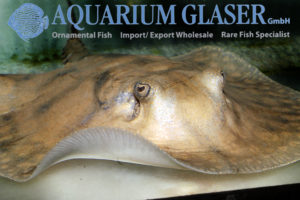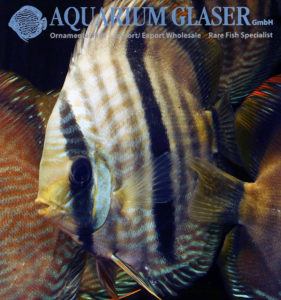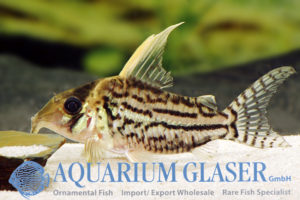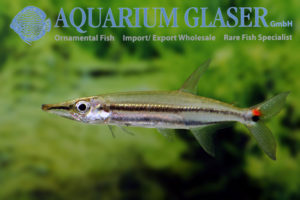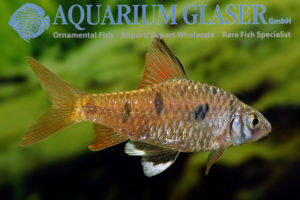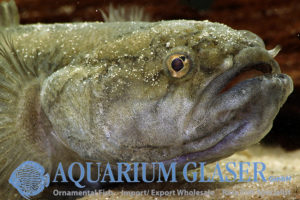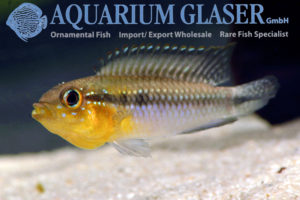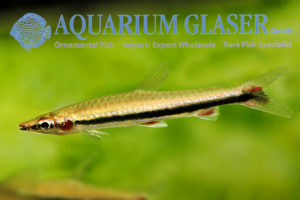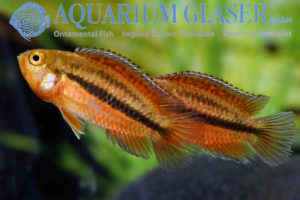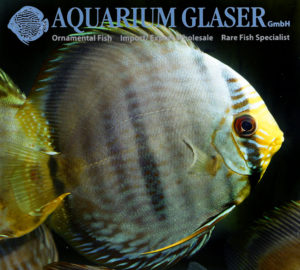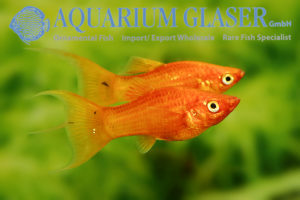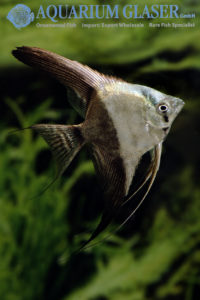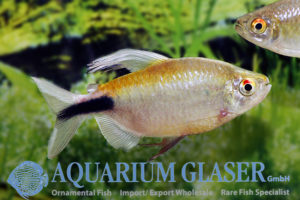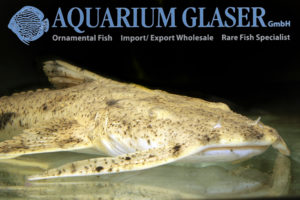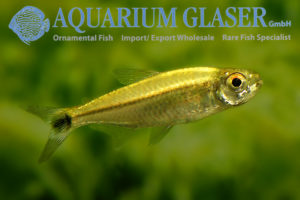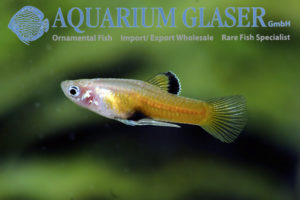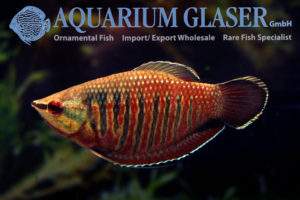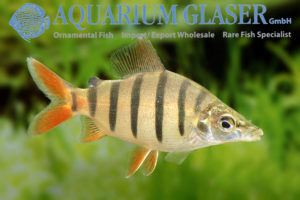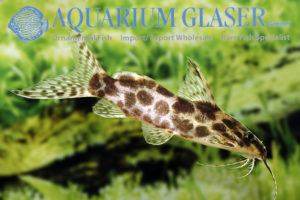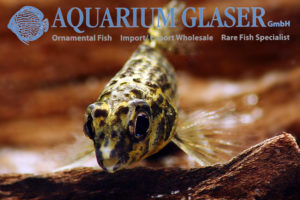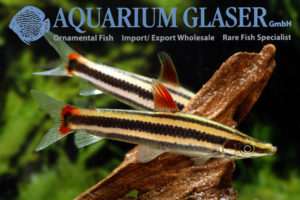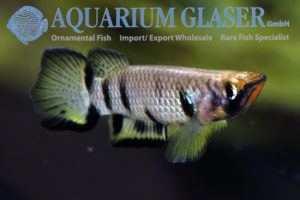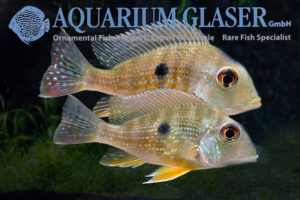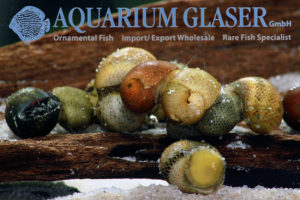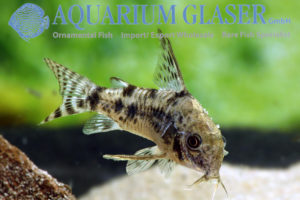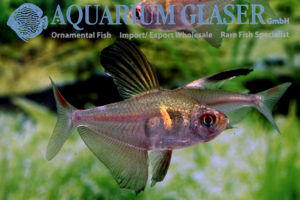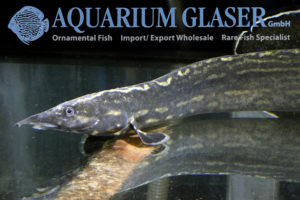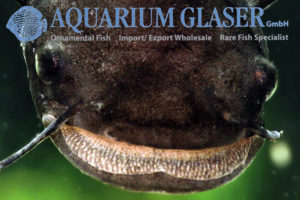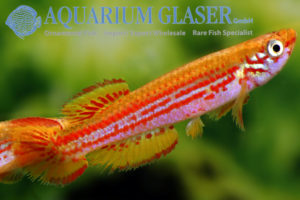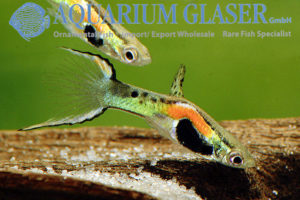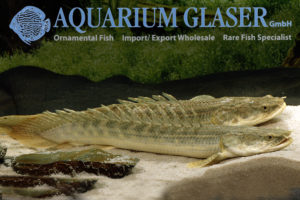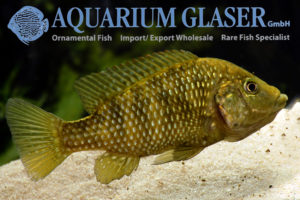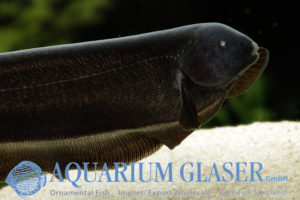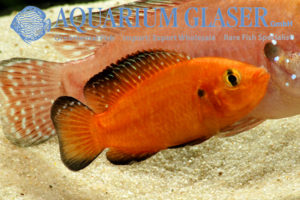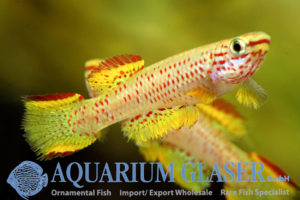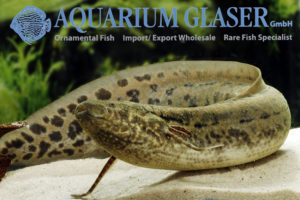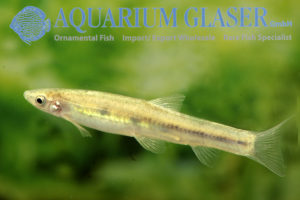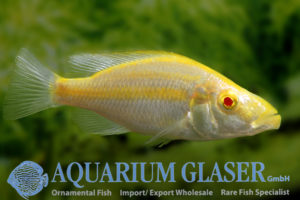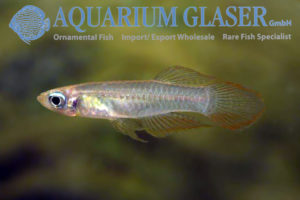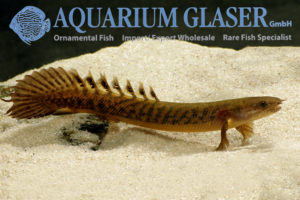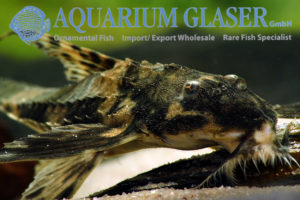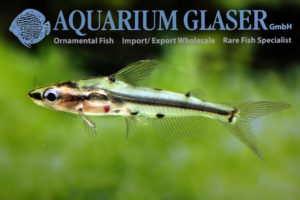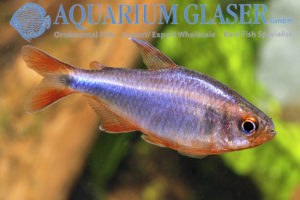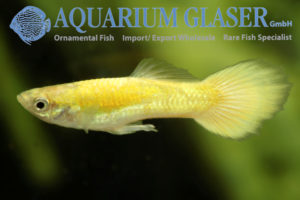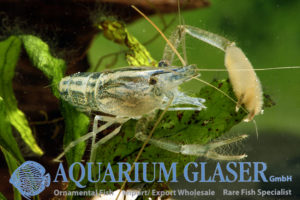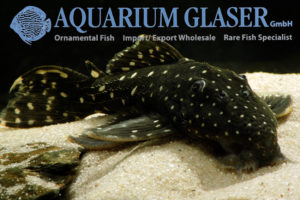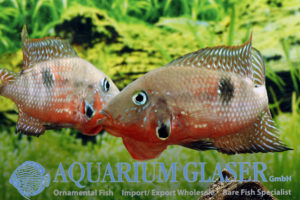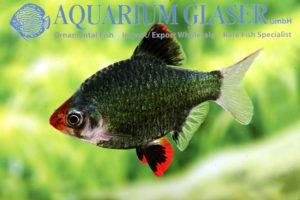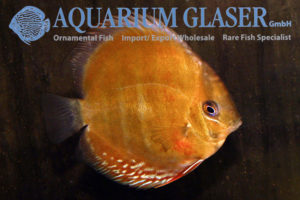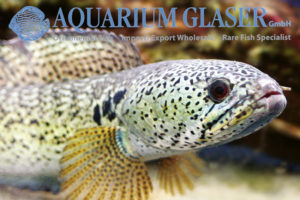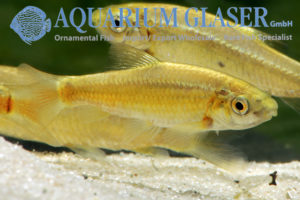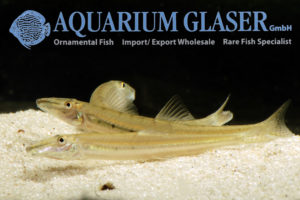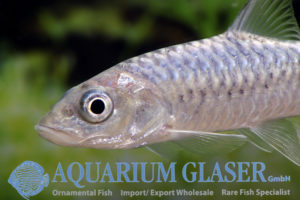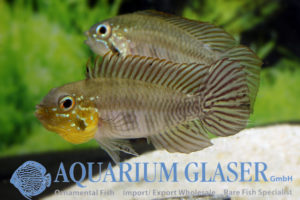Currently we can offer wonderful, fully grown Tetragonopterus argenteus from Paraguay. The species attains a length of 8 – 12 cm. Formerly the genus Tetragonopterus was a catch-all genus for small characins from South America. Most of them are placed now in other genera, for example Hemigrammus, Hyphessobrycon, or Moenkhausia. But still the common name […]
Fish Archive (2963)
-
-
Microphis aculeatus
Only very rarely we obtain the freshwater pipefish Microphis aculeatus from Nigeria. The fish belong to the free swimming members of the family and are very attractive. As in all pipefish the male has to care for the eggs until they hatch. The eggs are deposited in a pouch along the belly. So the male […]
-
Apistogramma mendezi Santa Isabel
Apistogramma mendezi belongs without any doubt to the most attractive members of the genus, but the animals we currently obtained from around Santa Isabel are even more attractive than usual. Of course the males of that population are as polychromatic as all Apistogramma males are, which means that hardly two males are looking identical, but […]
-
Gymnotus chaviro
More and more species of Gymnotus become known to science. Gymnotus chaviro originates from Peru. Here it inhabits the basin of the upper Rio Jurua. The species is found together with its close relative G. carapo. The pattern of G. chaviro is species-specific. However, there is one usefull feature mentioned in the original description: the […]
-
Myleus cf. torquatus
Shipments containing juveniles of silver dollars or pacus are always surprise packages. The juvenile coloration of many species is simply unknown and juveniles look totally different than the adults. So we can only guess that in our current case the fish from Venezuela may belong to the species Myleus torquatus. The smallest babies, about 1.5-2 […]
-
Corydoras sp. aff. sychri Longnose C53
From the Rio Nanay in Peru originates a species-flock of very similar looking corys. They are distinguished externally basically by the shape of the head and the snout. All of them are very beautiful and suited very well for the aquarium. All have an impressive dark mask over the eye and clear fins. The body […]
-
Hasemania nambiquara
This is a very unusual species of tetra. For sure the placement in the genus Hasemania is only tentatively and needs further investigations, as is explicitly pointed out already by the describers (Bertaco and Malabarba, 2007). It was the combination of lacking adipose fin (very unusual in tetras) and certain features of the dentation that […]
-
Hydrocynus vittatus
The systematics of the wolf tetras from Africa remain unsatisfying. According to the most recent literature there do appear two species in Nigeria, namely Hydrocynus forskahlii and H. vittatus. Both are very similar to each other and at times they were regarded to be mere synonyms. However, currently they are (again) treated as valid species. […]
-
Neolamprologus tetracanthus
This species of cichlid from Lake Tanganyika lives in two different worlds. The fish attains a maximum length of about 20 cm; however, in the wild hardly ever specimens larger than 10-12 cm can be found. On the one hand this fish is a typical inhabitant of sandy areas. Here it feeds on small invertebrates. […]
-
Hyphessobrycon piranga
Currently we can offer exclusively some top-rarities among the tetra family, all German bred. One of them is Hyphessobrycon piranga, which was introduced in the hobby by Peter and Martin Hoffmann in the German magazine Datz (issue 11/2017) under the unusual name of „Hyphessobrycon sp. non-red devil“. Despite the fact that the new tetra has […]
-
Neolamprologus cylindricus
Among the small species of cichlid from Lake Tanganyika Neolamprologus cylindricus is one of the prettiest. The very obvious ringed pattern makes it unmistakable. In respect of behaviour N. cylindricus is best comparable with the species of the genus Julidochromis. Like these N. cylindricus form fixed pairs (in large aquaria a male may pair with […]
-
Hemiloricaria lanceolata Red
It was back in the 1980ies that a brick-red sport of whiptail catfish appeared in the former GDR. The real origin of the fish stays a mystery, but it was possible to cross it with Hemiloricaria (formerly Rineloricaria) lanceolata. The strains that exist nowadays are most probably all hybrids. The initial red whiptail catfish belonged […]
-
Ctenopoma acutirostre
Among the most beautiful anabantoids or labyrinth fish from Africa is Ctenopoma acutirostre, the Leopard bushfish. It can become 15-20 cm long. Its natural habitat is the Congo. It is collected there for the ornamental fish trade in the Stanley Pool region. Here the fish live under the swimming meadows of the water hyacinth (Eichhornia […]
-
Micronemacheilus cruciatus (= Yunnanilus c.)
This charming free swimming dwarf loach originates from Vietnam. It attains a maximum length of about 3.5 cm. For quite a long time it was placed in the genus Yunnanilus, but currently mot scientists see them in the monotypical (this means the genus contains only one species) genus Micronemacheilus. These fish are totally peaceful and […]
-
Brotia armata
Currently we can offer several species of the livebearing snails of the genus Brotia from Thailand. These snails are no hermaphrodites like many other snails, but the sexes cannot be told apart from external features. However, Brotia will never become a plague like many other snails do. They feed on algae and other Aufwuchs. Water […]
-
Mesonoemacheilus guentheri
There are ten known species in the genus Mesonoemacheilus. They are small, 4-6 cm long, very lively loaches. All of them occur along the Western Ghats, a mountain chain along the west coast of India, the so called Malabar coast. These mountains border the inland against the Arabian Sea. The Western Ghats are a so […]
-
Pterophyllum scalare „Belem Sky Blue“
In the year 2015 along with an import of stingrays from Belem, Para, Brazil an angelfish was imported that was unknown to us until then. Already in 2016, in the F1 generation, a few blue mutants with a red iris could be selected. These blue angels from wild parents formed the basis of the selective […]
-
Guppy Endler Red Chest Saddleback
A few years ago we were able to import for the first time guppys that exhibited a black saddle bar over the back, starting at the base of the dorsal fin. These fish were called Yellow Half Tuxedo (see https://www.aquariumglaser.de/en/fish-archives/brandnew_guppy_endler_yellow_half_tuxedo_en/). An advancement of these guppys represents the Red Chest Saddleback. The breeder takes care that […]
-
Indostomus crocodilus
This Southeast Asian dwarf will never grow larger then 3 cm; we obatined the species recently again from Thailand. The gender difference is very easy to see, for the males have broad light seams along the dorsal, the ventral and the anal fins. Moreover, during breeding time the females are clearly more filled around the […]
-
Mormyrus rume
We obtain comparatively often this interesting mormyrid from Nigeria. Sadly systematics of Mormyrus are confusing. According to the latest scientific state of the art currently five species of Mormyrus occur in Nigeria, among them M. rume. The shape of the snout is the best feature to distinguish the species. Formerly the fish portayed here was […]
-
Pethia padamya wild
The origin of the Odessa or Rubin barb was unknown for almost 30 years. The first specimens appeared in the former USSR in Odessa. It was unknown for a very long time whether they represented a wild species or an artifical breeding product. Only 2001 the first wild collected specimens could be traced. Now it […]
-
Pseudacanthicus cf. leopardus: L 114 big and small
The L-catfish L 114 is a close relative of Pseudacanthicus leopardus (please see our entrance on LDA 7 for that); currently we have different sizes of the beautiful L 114 in stock, among them (very rarely offered) 25-30 cm long specimens which are almost fully grown and in any case mature and one of the […]
-
Periophthalmus barbarus
The mudskippers (Periophthalmus) are among the most fascinating fishes at all. One can observe mother nature´s laboratory and how an aquatic animal becomes a landdwelling animal based on the observation of these fishes. The Atlantic Mudskipper (P. barbarus) attains a maximum length of about 15 cm and is one of the larger species of the […]
-
Ambastaia sidthimunki
From northern Thailand originates the dwarfish Checkerboard Loach formerly known as Botia sidthimunki, then as Yasuhikotakia s. As it is a rather small (6 cm) and very peaceful species, it represents an ideal member for an asiatic community tank. There it can be kept together e.g. with small representatives of the genera Danio, Rasbora and […]
-
Hyphessobrycon elachys
Among the smallest species of tetra is Hyphessobrycon elachys, the veilfin tetra from Paraguay. The species becomes only 1.5-2 cm long (standard length without caudal fin). The charming animals inhabit swampy areas in the Rio Paraguay drainage. The genus Hyphessobrycon, as it is currently defined, represents an artifical assamblage of species which are not very […]
-
Panaqolus albomaculatus LDA 31 Venezuela
In one of the most current issue of the Datz magazine (Datz 3/2018) a new L-number has been published, namely L501. This is a Hypancistrus from Venezuela belonging in the closer relationship of Hypancistrus inspector/L201/L339. It differs from the so far known relatives by the almost unspotted fins and the rather pinkish/orange spots (instead of […]
-
Sciaenochromis fryeri „Iceberg“
Many species of rock-dwelling cichlids from Lake Malawi – the so-called Mbuna – live on isolated places. These place are often many miles away from other suitable habitats. This geografic isolation leads comparatively fast to local colour morphs. Other species of cichlid from Lake Malawi are not that much specialized and can live in a […]
-
Eirmotus octozona
The Eightbanded barb (Eirmotus octozona) is a very delicate, slightly transparent dwarf barb from blackwaters of Malaysia and Indonesia. The males are much smaller than the females and sometimes even look as if they were half famished. But this is normal. Besides this males have comparatively larger ventral fins. The fish gets the most intensiv […]
-
Sphaerichthys osphromenoides
Sphaerichthys osphromenoides is the most famous representative of the in southeast Asia indigenous chocolate gouramis. Like other chocolate gouramis Sphaerichthys osphromenoides is a delicate and at least while settling down a sensitive fish. It’s natural biotope are shore areas of small, still and slow-moving black water on the Malayan peninsula and Sumatra. As a typical […]
-
Channa sp. 5-stripe
This comparatively small species of snakehead originates from the north of India (Assam, North-Bengal). The species is not described scientifically yet. Initially it was erranously reported to originate from Kerala (which is in the south of India). The species is a mouthbrooder and attains a maximum size of 15-20 cm. Due to the origin in […]
-
Xiphophorus maculatus Platy Coral Kohaku
White-red sports in Xiphophorus are pretty demanding for the breeder. Interestingly these fish are all usually born in a crystal red coloration. Only after a few weeks the red breaks up and white patches become visible. Some of the fish become totally white when fully grown, others totally red, but most of them show red […]
-
Caridina dennerli
When the White Spot Bee Shrimp appeared about 10 years ago for the first time in larger numbers in the ornamental fish trade we all where really enthusiastic about them. Sadly we had to learn that the tiny animals are very sensitive against temporary distress, for example low temperatures during transportation, and die very quickly […]
-
Leporacanthicus triactis L91 Variety
The tooth-nose Leporacanthicus triactis from Venezuela s a beautiful aquarium fish that has a number of advantages. Besides the very nice coloration it does not become too big (maximum size reported is about 30 cm, but most specimens in the wild stay much smaller) and it is an omnivorous fish that readily accepts all types […]
-
High End Guppys
Currently we can offer several High Quality German Bred Guppys. This breeder is specialized inbreeding rare varieties that are offered by pair, which means that the genetically correct female is supplied along with the male. The sports illustrated here – „Full Platinum Albino“ and „Yellow Tuxedo“ – are only two of serveral ones we have […]
-
Goldfish Oranda 2-3 Colour
In the minds of many keepers the goldfish is a coldwater fish and has its high season in spring time, when the garden pond season starts. This is of course true, but reflects only a part of the reality. The highly developed sports – like the orandas – often are better kept in aquaria than […]
-
Micracanthicus vandragti L280
One could think that this unusual suckermouth catfish – it originates from the Rio Ventuari in Venezuela – represents the juvenile form of a Leporacanthicus, for example L240 or L241. But in fact L280 is a dwarf species that hardly ever becomes bigger than 5 cm. Until now only single specimens appeared in the trade, […]
-
Pangio anguillaris
The Kuhli loaches (Pangio, formerly Acanthophthalmus) form an important part of all smaller community tanks with a southeast Asian character. Here the small „watersnakeletts“ are cleaning and feed all the small food particles that might have been overlooked by the other fish. Of course the loaches have to be fed also; this is no problem […]
-
Pethia conchonius Neon Red
The neon red ruby barb is an artifical sport of the ruby barb available for many years already. The fish are extremely beautiful; we usually obtain them from breeders from southeast Asia. Now we received this sport from an European breeder and his strain is particually beautiful. Like in the Asian cousins the flanks are […]
-
Poecilia reticulata Guppy Yellow Taxi Glass Belly
These Glass Belly Guppys are very special. Their coloration lacks not only all black pigment – they are true albinos – but also the silver pigmentation of the abdomen. So one can study the complete develepment of the eggs and youngsters in the belly of the female fish. This means these fish are a perfect […]
-
Akysis portellus
The wasp catfishes (Akysis) become more and more popular in the aquarium hobby. Their common name refers to venomous glands these fishes have at the base of the dorsal and the pectoral fins. A sting by the spines of these fins is very painful, though it it is harmless; only allergy sufferers should be double […]
-
Guyanancistrus guahiborum L106
Currently we have extremely nice youngsters of L106 in stock. They originate from Venezuela. There is a second, very similar L-number, L122. L106 has a deeper body. Maximum size reported for L106 is about 15 cm, recently our fish are 4-6 cm long. The species has been described scientifically in 2005 under the name of […]
-
Rasbora daniconius
The slender rasbora (Rasbora daniconius) inhabits a very large area in Southeast Asia. From the Malaian peninsula to the Mekong and the Indus it occurs in the a variety of habitats: channels, ponds, flooded (rice) fields and slowly flowing rivers. Due to the enormous area and the adjustment to different water types it can be […]
-
Apistogramma trifasciata
In case this dwarf cichlid would not exist it would be necessary to invent it for the aquarium hobby. Apistogramma trifasciata is an ideal aquarium inhabitant. The species stays small – males around 5 cm, females around 4 cm. It is completely undemanding regarding water chemistry – keeping and breeding is possible even in medium […]
-
Corydoras amapaensis
The beautiful long snouted Corydoras amapaensis is a top rarity in the ornamental fish trade. Only very occisonally, every 5-6 years, some specimens can be imported. So we are very glad that we can offer now for the first time some bred ones. The fish are currently about 4 cm long and have just reached […]
-
Exodon paradoxus
For many aquaristis the Bucktooth tetra, Exodon paradoxus, is simply the most beautiful tetra from South America. The splendid fish glitter and glimmer like diamonds and they never stay still. They hunt and hit their conspecifics permanently and an uneducated watcher may become quite concerned that the fish will eventually hurt each other. But this […]
-
Sicyopus rubicundus
We received from Indonesia once more a nice shipment containing pretty Sicyopus gobies. These gobies are – despite the external similarity – not feeding on Aufwuchs and microfilm like Stiphodon and Sicyopterus, but are little predators that feed on quite large food items. These include also very small fish and shrimps up to a length […]
-
Potamotrygon wallacei
This freshwater stingray lives endemically in the Rio Negro system in Brazil and is or was the most often imported species of Potamotrygon from Brazil at all. However until recently they fish were wrongly identified as P. histrix, a different species that is not kept in aquaria at all and occurs in southern South America. […]
-
Symphysodon discus Blue Head Tumbira
Here, as promised, another remarkable Heckel variety we currently have in stock: Blue Head Tumbira. One should not think that every specimen of that variety has a solid blue opercle; Tumbira (the name refers to a Tukano community at the bank of the Rio Negro, below Sao Gabriel de Cachoeira) are still wild collected discus […]
-
Corydoras sp. C141 (2)
We have the beautiful Corydoras sp. C141 – this species is obviously not described scientifically yet – in stock on a regular basis. The exact place of origin is still unknown, we obtain the fish under the wrong name of „Corydoras ornatus“ from Brazil. However, Corydoras ornatus is a different species. Currently we have some […]
-
Acestrorhynchus isalineae
The barracuda tetras (Acestrorhynchus) a good aquarium fishes, although they are predators that prefer to feed on small other fish. Most species are medium sized – about 20-30 cm maximum length – but there do exist also dwarf species. Among the latter is A. isalineae. This species attains only 7.5 cm in standard length, this […]
-
Puntius sahyadriensis
The Khavlibarb originates from the Yenna River in Satara district in the Indian state of Marahashtra. This is a peaceful species, which could however nibble on fresh sprouts of aquarium plants. They can be kept with any peaceful tank mates without any problems. The aquarium should be decorated with robust plants and part of the […]
-
Odonteleotris macrodon
We obtained from Thailand five specimens of that odd goby which are about 15 cm long. Our first idea was that they would belong to the species Oxyeleotris urophthalmus. The genus Oxyeleotris is repersented by three species in Thailand, two of them with an ocellus in the upper part of the caudal peduncle. Both are […]
-
Apistogramma gephyra wild
Since its scientific description in 1980 this dwarf cichlid is subject of an ongoing debate among keepers and breeders of Apistogramma. Some think that A. gephyra is a mere variety of A. agassizii, others defend its status quo as a separate species. Most likely both parties are right. There can be no doubt that A. […]
-
Nannostomus harrisoni
The Blackstripe pencilfish has been described from Guyana scientifically back in 1909. Here he fish inhabits exclusively the Demerara river basin. The beautiful species attains a maximum length of 4.5 cm and is very peaceful. Formerly the fish was placed in a separate genus, namely Poecilobrycon, due to the long snout. In the meantime the […]
-
Nannacara anomala
Here we have once more an animal that has delighted already our grandparents. Nannacara anomala, the Goldeneye cichlid from Guyana is an all-time ornamental fish classic. However, the fish we currently have in stock, are extraorbitant colourful. We obtained them from a hobby breeder who obviously spent a lot of love and enthusiasm in an […]
-
Symphysodon discus „Heckel Nova Olinda“
We are now in the last third of the current discus season. A particular charakter of this season is the comparably great number of extremely beautiful Heckel discus. We currently have a number of varieties in stock and want to feature them for you. But of course it is not that easy to take pictures […]
-
Molly Copper Lyretail
A beautiful sport of Molly from Singapore is Copper Lyretail, a very colourful variety. Obviously the species Poecilia sphenops formed the basis of that strain. The combination of the colour copper and the lyretail led to males in which the anal fin is much too broad to serve as a gonopodium. So the pure males […]
-
Pterophyllum scalare „Bicolor Blue“
We can offer this brandnew sport of the Angelfish (Pterophyllum scalare „Bicolor Blue“) for the very first time now. The animals still differ individually in respect of pattern, but especially the front back of all specimens is already blue. The breeder guaranteed us that the parents are full blue bicolor with a real intensive colour. […]
-
Bryconalestes longipinnis
The African Longfin Tetra (Bryconalestes longipinnis, = Brycinus longipinnis) is a classic ornamental fish from Nigeria; we have it almost anytime in stock. Usually the fish traded are 3-5 cm long, which means that they are about half grown (maximum size reported for that species is 16 cm, but this is as rare as a […]
-
Bagarius suchus
There are currently four species placed in the genus Bagarius, which are called devil catfish. The biggest one, which grows up to 200 cm in length, is Bagarius yarelli. It can be found in many parts of south and south-east Asia. The smallest is Bagarius bagarius, which grows up to only 15-20 cm and comes […]
-
Hemigrammus levis Gold
It is very difficult to determine gold tetras. The golden coloration is the skin reaction on a harmless infection with a parasite. If a tetra feeds the faeces of a fish-eating bird that contains the eggs of the parasite – a worm – in the intestine of the fish the eggs hatch and the larvae […]
-
Phallichthys tico
Once more we are able to offer this top-rarity among the livebearers. The charming fish – males reach a maximum length of about 2.5 cm, females 4.5 cm – are restricted to the upper reaches of the river San Juan in Costa Rica and Nicaragua. No commercial fishing for ornamental fish does exist there and […]
-
Sphaerichtys vaillanti
Finally we can offer again the most beautiful species of Chocolate Gourami: Sphaerichtys vaillanti. The species originates from the Kapuas basin in the Indonesian part of the island of Borneo. S. vaillanti is not only the most beautiful, but also the hardiest species of all Chocolate Gouramis. However, it is nevertheless by no means an […]
-
Distichodus lusosso
The longsnout distichodus has a very wide distribution in the Congo basin. The species attains a length of up to 40 cm; we recently obtain extremly charming, small juveniles. D. lusosso is an omnivorous fish; a great part of the food is plant material, so a planting of the tank is usually not possible. One […]
-
Synodontis soloni
We obtained a very rarely offered squeaker catfish from the Congo: Synodontis soloni. The species is medium sized (for squeakers): 20-25 cm long specimens can be called real big ones. The large caudal fin and the slender body give hints that this is a rheophilic species. Against conspecifics our specimens, which are currently 12-15 cm […]
-
Melanocharacidium cf. dispilomma
We obtained this charming ground tetra from Brazil. Melanocharacidium dispilomma has a very wide distrubution in northern South America. There are scientific reports from Bolivia, Brazil, the Guyana countries, Venezuela, and Colombia. There is a strange contrast between this very wide distribution and the fact that M. dispilomma has been described scientifically only in 1993. […]
-
Anostomus anostomus
The Striped Headstander is one of the most beautiful species of tetra from South America. It really looks like the big brother of the Threestripe pencilfish, Nannostomus trifasciatus. Anostomus anostomus attains a maximum length of about 15-18 cm. Sadly there are hardly ever exportations of ornamental fish from Guyana currently, so the beauty became rare […]
-
Epiplatys dageti monroviae
This panchax belongs without any doubt to the most popular killifish at all. There are many reasons for that: the beautiful coloration, the small size (4-5.5 cm), the fact that these fish can be kept in community tanks, and the adaptility to many different water conditions are some of them. The Red Chinned Panchax is […]
-
Geophagus cf. abalios
Currently we have as well larger wild collected specimens and bred ones in stock. G. cf. abalios is a beautful, ovophilous mouthbrooider and originates from Venezuela. The fish have bred in our showroom. At that time they had a total length of about 8 cm, so we initially thought they would represent a dwarf variety. […]
-
Nerita polita
We obtained the charming algae snail Nerita polita from Thailand. This „racing snail“ is also known by the popular name of Polished Nerite. It inhabits large parts of the Indo-West-Pacific and is extremely common. It was described scientifically as early as 1758, the year of birth of the scientific naming of organisms, by Carl von […]
-
Corydoras longipinnis
We were able to import an interesting Corydoras species from Paraguay, namely Corydoras longipinnis. This species has been scientifically described as recently as 2007 by Joachim Knaack. The new species is a close relative to the well known Corydoras paleatus and reminds one somewhat of the longfinned sport of that species. In Corydoras longipinnis only […]
-
Hyphessobrycon paepkei
The Goldshoulder rosy tetra, Hyphessobrycon paepkei, has been described only a few years ago, the type specimens originated from our fishhouse. THe natural distribution is in the Rio Negro in Brazil. Usullay onyl a few specimens could be selected from shipments of other species, but now we are able to offer the beautiful Goldshoulder rosy […]
-
Mastacembelus unicolor
We import the beautiful fire eel, Mastacembelus erythrotaenia, on a regular basis from Indonesia, usually large specimens, 30-60 cm long. These fish are about as thick as a forearm. Most recently we obtained again four specimens, 50-60 cm long. However, two of them looked totally different. They lack completely the red stripes and spots which […]
-
Wallagonia micropogon
This is a fish like an evening in a swamp: dark and spooky. Wallagonia micropogon is a predator, anyone can see. The validity of the species W. micropogon is the subject of controversial discussion, many scientists believe that it is a synonym of Wallagonia leerii. Our specimens originate from Thailand. Currently they are small, only […]
-
Aphyosemion punctatum
This gorgeous killi originates from Gabon. We can currently offer very nice German bred ones. The beautiful red and yellow colours fit perfect in the x-mas time, don´t they? Keeping and breeding the up to 4.5 cm long species can be compared with the by far better known lyretail killi, Aphyosemion australe. For our customers: […]
-
Guppy Endler Black Bar
There are so many new sports in Endler guppys (Poecilia wingei); it is really difficult to keep the overview. Sadly some of these new sports loose the charme of the wild type fish which are characterized by the very tiny males (usually they should not grow larger than 1.5 – 2cm) and the overboarding vivacity. […]
-
Polypterus lapradei
Napoleon Bonaparte was leader of a campaign through Egypt in the years 1798-1801. He was followed by 169 scientists, among them the zoologist Étienne Geoffroy Saint-Hilaire. After the return to France, Saint-Hilaire described a very strange species of fish he collected in the Nile river in Egypt under the (vernacular) name of Polyptère bichir. The […]
-
Danakilia sp. Sukoray
Danakilia are very strange cichlids that were described scientifically only very recently and were – of course – totally unknown in the hobby, until Anton Lamboj was able to bring some specimens alive back to Austria from Etritrea. He made this expedition together with Giorgio Chiozzi from the Milan Museum. One of the new discovered […]
-
Sternarchogiton preto
Most probably this importation of this black knifefish from Peru („preto“ means „black“) is the first one to Europe. At least the pictures of a life specimen we post here are the only ones we know about. The uniform black coloration is a good feature to distinguish the species from other members of the genus […]
-
Hemichromis exsul
Red jewel cichlids are wonderful aquariumfishes despite the fact that sometimes very quarrelsome individuals appear. For scientists the complex of species of red jewel cichlids remains a mess. Many meristic features overlap and additionally many species are highly polychromatic. Hemichromis exsul has been described scientifically already in 1933 under the name of Pelmatochromis exsul. Type […]
-
Aphyosemion gabunense marginatum
The concept of subspecies is denied by many recent ichthyologists. They argument that there are either differences – in that case the fish are full species – or there are no differences – in that case they don´t have to be named at all. However, this argumentation does not consider the existing fact that both […]
-
Protopterus annectens Nigeria
There are four species of lungfish occuring in Africa. It is sometimes pretty difficult to distiguish them. In any case the Westafrican Lungfish (Protopterus annectens) is the most common one in the ornamental fish trade, although „most common“ has to be seen as very nuanced. These fish become almost a metre long and are very […]
-
Kneria stappersii
We can offer now for the first time a species of the strange genus Kneria (shellears) as German bred ones. Nobody will buy a shellear for the bright coloration. These fish become about 5 – 7.5 cm long (depending on the species). They have a number of peculiarities that make them extremely interesting from a […]
-
Dimidiochromis compressiceps Albino
There is no consensus among aquarists regarding albino sports. One part of the hobbyists find them awkward, the other part simply wonderful. Readers belonging to the first group: please accept our excuse, next week a different fish will be subject of the post again. For all the others: The Malawi-Eyebiter (Dimidiochromis compressiceps) has a bad […]
-
Aplocheilichthys normani
A real classic among the species of fish that Takashi Amano preferred to use for his legendary nature aquaria setups is Aplocheilichthys normani (= Poropanchax normani). A single specimen of that lampeye is a rather drab creature, but a larger school of them in a tank with dimmed light is like magic! The blue eyes […]
-
Polypterus teugelsi Bred
The Cross river in Western Africa is a legendary river. The course of the river starts in Cameroon, the lower part flows through Nigeria. The river is famous for its high degree of endemic species; „endemic“ means that the species occurs only there and nowhere else. Among the endemic species are for example Tetraodon pustulatus […]
-
Brochiloricaria macrodon
We received from Paraguay this wonderful mouthbrooding whiptail catfish. Once we had this species even as bred ones in stock – many years ago. In our recent import the prolongations of the fins are very obvious. This reminds a bit in Lamontichthys. However, Brochiloricaria has a completely different mouth structure and feeding habit. Brochiloricaria are […]
-
Hyalobagrus flavus
Back in 1903 Georg Duncker from the Hamburg Museum described a small species of catfish from the Malay Peninsula under the name of Pseudobagrus ornatus. The description appeared in the same famous paper in which the harlequin barb (Trigonostigma heteromorpha) and the dwarf rasbora (Boraras maculatus) were described. In contrast to the two barbs, which […]
-
Hyphessobrycon wadai
We are very glad to be able to offer this beautiful tetra for the first time now. The fish are German bred ones. The species has been described only in 2016. The natural distribution is the upper basin of the Rio Tapajós. This tetra is already a popular aquarium fish in Sao Paulo (Brazil) since […]
-
Guppy Platinum Gold
The latest creation from the jewellery Sri Lanka: Platinum Gold. This fish is a further development of the Guppy Full Platinum, which we obtained in August, also from Sri Lanka. The yellow or golden coloration differs a lot individually in the Platinum Gold. Some specimens look like the Full Platinum, just with a yellowish tinge, […]
-
Macrobrachium scabriculum
We have obtained once more beautiful chameleon shrimps (Macrobrachium scabriculum) from India. The common name for that species has been given by Uwe Werner due to the change of the basic coloration during the life. Initially these shrimps are translucent, then they usually become blueish, then brownish and finally almost black. Only the contrasting stripe […]
-
Leporacanthicus sp. L326
This unusual Leporacanthicus originates from the Orinoco. The L-number was given already back in 2002. Initially the fish was imported from Colombia. It is said that these fish were collected in the area around Puerto Carreño. We currently received this fish for the first time ever; our specimens come from Venezuela. L326 differs from all […]
-
Thorichthys meeki
The Firemouth (Thorichthys meeki, formerly Cichlasoma meeki) originates from Mexico and belongs to the most popular cichlids at all. This popularity is not at least due to the impressive face mask of the species. No other species of cichlid shows in such perfectness the bottom of the mouth and the deep red skin that covers […]
-
Puntigrus anchisporus „Moss Green“
Many people will still know the tiger barb under the wrong name Barbus or Puntius tetrazona. This species – the correct name is Puntigrus tetrazona – is, however, never kept in aquaria or traded, but exclusively the close relative Puntigrus anchisporus. Both species can be easily distinguished from each other by the colour of the […]
-
Madeira-Discus arrived!
There are so many varieties of discus known, but none of the wild collected fish are as variable as the ones from the Rio Madeira. Basically speaking, the Madeira discus is a brown-blue one. The brown morphs of that variety very often exhibit a high degree of red and/or yellow colour on the body, while […]
-
The total ban of Channa in the EU is off the table!
According to our very well informed sources the application to ban the trade and keeping of all species of snakehead (Channa) in the EU has been refused. Obviously just in time the contradiction could be submitted that the ban of a complete genus is not according to the law, but that in any case for […]
-
Garra culiciphaga
A quite new fish in the hobby is Garra culiciphaga. Initially this species has been described by the French scientist Pellegrin in 1927 under the name of Hemigrammocapoeta culiciphaga. The up to 8 cm long fish was placed in the genus Hemigrammocapoeta since 2015; recently specilaized researchers see it rather in the genus Garra. The […]
-
Acantopsis rungthipae
You don´t know that name? We didn´t either, until some days ago a taxonomical revision of the horseface loaches of the genus Acantopsis was published. All loaches of the genus used to be named Acantopsis dialuzona in the trade (sometimes the synonym A. choirorhynchos was also used). Currently seven different species are considered to be […]
-
Tor putitora
The Mahseer carps from India are mythical fishes. They belong to the largest carp species of the subcontinent and it is said that they can reach up to 2 m in length. These carps inhabit the same ecological niches in India that are held in Europe by the salmons and trouts. Like in the latter […]
-
Apistogramma gibbiceps
Currently we received once more this pretty dwarf cichlid from the Ro Negro basin. It is a typical company of the cardinal tetra in the wild. The species Apistogramma gibbceps cannot be confused with any other species of Apistogramma when it shows the species-specific vertical bars on the belly. Sadly these bars are not visible […]
- « Previous Page
- 1
- …
- 10
- 11
- 12
- 13
- 14
- …
- 30
- Next Page »





